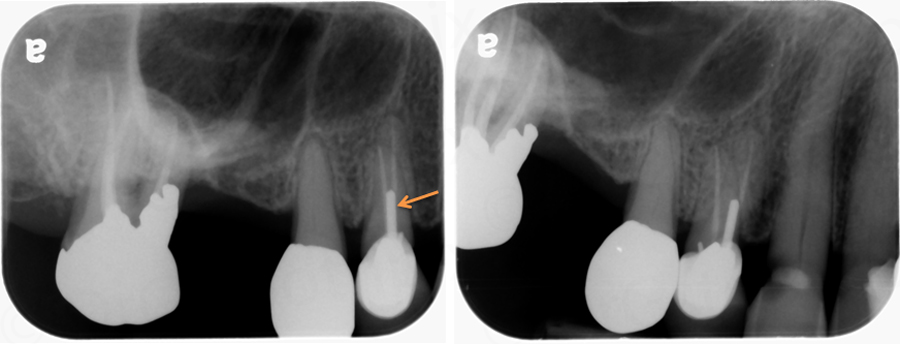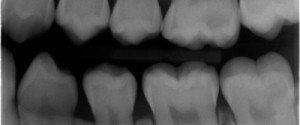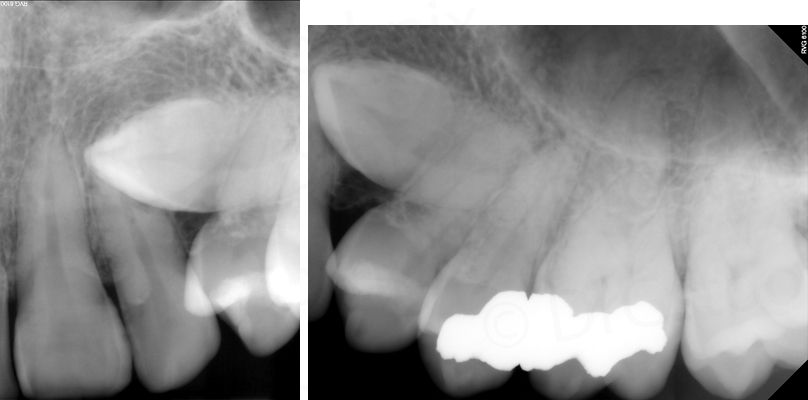Now for the answers from yesterday’s post as I apparently didn’t schedule it correctly.
Which root is the post (orange arrow) in?
Before starting to use the image shift principle it is important to know/remember two key points
- Images move in the opposite direction from the movement of the source.
- Images of objects farther from the image receptor will move more (aka objects (images) more facial/buccal will appear to move more).
The first thing to do is pick a stationary object that is seen on both radiographs and appears to move in comparison to the post of the maxillary right first premolar (#5). On these radiographs, we will use the other endodontically treated root of the maxillary right first premolar (#5).
The next step is to determine what angle change is obvious between the two radiographs? Positive vertical angle, negative vertical angle or horizontal angle.
The most obvious angle change is the horizontal angle between the two radiographs. Starting with the maxillary right molar periapical radiograph and moving to the maxillary right premolar periapical radiograph, the horizontal angle decreases meaning the source of radiation (tubehead) moves anteriorly. According to point 1 above, this means the images move posterior.
Looking at the second radiograph (maxillary right premolar periapical radiograph), we need to compare the image movement of the post of the maxillary right first premolar (#5) versus the other endodontically treated root of the maxillary right first premolar (#5) to see which object moved more posterior following point 2 listed above.
The other endodontically treated root of the maxillary right first premolar (#5) appears to be more posterior on the maxillary right premolar periapical radiograph meaning it is farther from the image receptor compared to the post of the maxillary right first premolar (#5).
This gives us an answer of the post of the maxillary right first premolar (#5) being to the lingual/palatal of the other endodontically treated root of the maxillary right first premolar (#5).
SLOB (Same-Lingual, Opposite-Buccal)
We will use the same objects as above (unknown object = post of the maxillary right first premolar (#5) and fixed object = other endodontically treated root of the maxillary right first premolar (#5)).
Next, we need to determine which direction we are moving from the maxillary right molar periapical radiograph to the maxillary right premolar periapical radiograph and the answer would be – mesial.
On the maxillary right premolar periapical radiograph determine what direction does the post of the maxillary right first premolar (#5) appear to have moved in relation to the other endodontically treated root of the maxillary right first premolar (#5) – mesial.
Here is where the acronym comes into play. Did the unknown object move in the SAME direction as the radiographs or in the OPPOSITE direction?
Our answer is – same and the acronym states that same is lingual, so the post of the maxillary right first premolar (#5) is to the lingual of the other endodontically treated root of the maxillary right first premolar (#5).
If you have any questions or comments, please leave them below. Thanks and enjoy!




But here hasn’t the x-ray tube been shifted mesially since it is parallax technique? The first radiograph the beam is straight ( I ) but 2nd the beam shifts like this ( / ).
Hence, the post moves in the opposite direction?
It sounds like you are combining the image shift principle and SLOB rule. They need to be evaluated separately. If you want to work the case in relation to the tube head shift, you should use image shift only and not the SLOB acronym. Does this help?